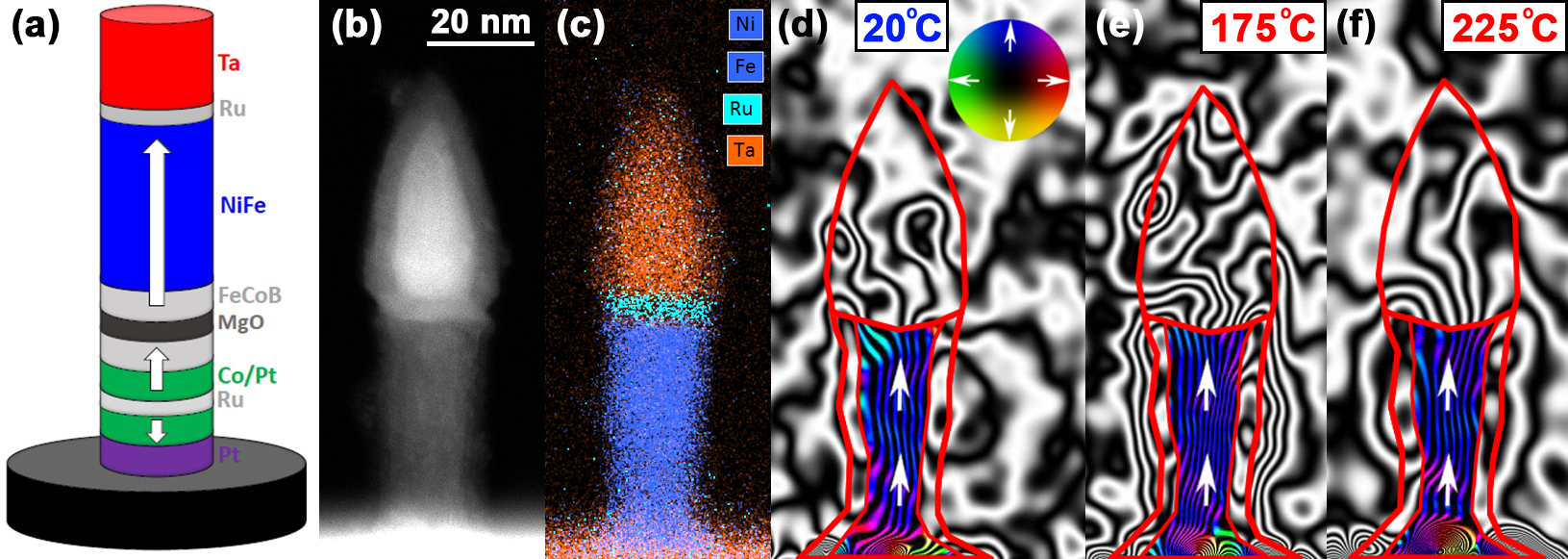An off-axis electron holography investigation of the perpendicular shape anisotropy and thermal stability of STT-MRAM nano-pillars
- Abstract number
- 12
- Presentation Form
- Poster Flash Talk + Poster
- Corresponding Email
- [email protected]
- Session
- Stream 2: EMAG - In-situ microscopy
- Authors
- Dr Trevor Almeida (2), Dr Steven Lequeux (1), Mr Alvaro Palomino (1), Mr Nuno Caçoilo (1), Dr Aurélien Masseboeuf (1), Dr Ricardo Sousa (1), Dr Olivier Fruchart (1), Dr Ioan Lucian Prejbeanu (2), Dr Bernard Dieny (1), Dr David Cooper (2)
- Affiliations
-
1. Univ. Grenoble Alpes, CEA, CNRS, SPINTEC
2. Univ. Grenoble Alpes, CEA, LETI
- Keywords
Off-axis electron holography
In-situ TEM
Nanomagnetism
MRAM devices
- Abstract text
Summary
The magnetic properties and thermal stability of STT-MRAM nano-pillars is investigated using off-axis electron holography. Energy dispersive X-ray spectroscopy reveals the 3:1 aspect ratio of the magnetic FeNi section within the nano-pillars, whilst electron holography confirms this elongated shape induces a favoured magnetic easy axis. Combining electron holography with in-situ heating demonstrates that this high aspect ratio provides a perpendicular shape anisotropy that is thermally stable up to 225°C, and hence resistant to thermal variations during operation.
Introduction
Magnetic random-access memory (MRAM) is a non-volatile memory based on the storage of one bit of information by a ferromagnetic memory carrier. Spin-transfer torque (STT) MRAM is viewed as an exciting replacement for embedded FLASH memory and has attracted great interest by the microelectronics industry. Out-of-plane STT-MRAM involves the use of a magnetic tunnel junction (MTJ) comprising an MgO tunnel barrier (1 – 1.5 nm) sandwiched between two thin perpendicularly-magnetized layers: one magnetically-pinned reference layer, and one switchable storage layer. The electrical resistance of the MTJ changes significantly when the layers are magnetized in parallel and antiparallel states, providing a system of readable / writable ‘0’ or ‘1’ binary information. The areal bit density of modern STT-MRAM can be improved further by reducing the in-plane size of the MTJ, which however may reduce the thermal stability of the storage layer. One solution is to increase the storage layer thickness to larger than its diameter so that its out-of-plane aspect ratio provides additional thermal stability through perpendicular shape anisotropy (PSA). Previous studies have shown that the PSA-STT-MRAM are indeed highly thermally stable, making them an exciting solution to downsize scalability of STT-MRAM at sub-20 nm technology nodes1,2. However, our knowledge of the thermal stability of these STT-MRAM nano-pillars is often indirect, relying on magnetoresistance measurements and micromagnetic modelling. In order to understand fully their thermomagnetic behavior, it is necessary to examine the effect of temperature directly. The advanced transmission electron microscopy (TEM) technique of off-axis electron holography allows imaging of magnetization within nano-scale materials. Here, we use electron holography to image the micromagnetic configuration of the nano-pillars in the presence of PSA and to visualize its thermal stability through in-situ heating.
Methods/Materials
An array of FeCoB / NiFe nano-pillars was fabricated through sequential e-beam lithography, reactive ion etching and ion beam etching1. TEM samples were prepared by depositing a protective layer (~ 1 µm) of resin on the array prior to a protective Pt layer being deposited by the focused ion beam (FIB). Cross-sectional TEM lamellae were transferred to Omniprobe copper slots and thinned to ~ 300 nm using conventional FIB methods. The protective resin layer was removed by plasma etching and the remaining Pt layer was broken with the micromanipulator. Scanning TEM (STEM) imaging was performed using a probe-CS-corrected Thermo Fisher Titan TEM at 200kV, whilst energy dispersive X-ray (EDX) spectroscopy provided chemical analysis. Off-axis electron holograms were acquired under field-free conditions in Lorentz mode on a Gatan OneView 4K camera using a Thermo Fisher Titan TEM equipped with an image-CS corrector and an electron biprism. The magnetization states of the nano-pillars were visualized through separation of the magnetic contribution to the phase shift from the mean inner potential (MIP), achieved by tilting and applying the strong field of the objective lens (< 1.5T) to reverse their magnetism. In-situ heating up to 250°C was performed using a Gatan heating holder under field-free magnetic conditions. The heating was repeated and the magnetic reversal was performed at each temperature interval to isolate the MIP, and subtracted from the first heating to reconstruct the thermomagnetic behavior of the nano-pillars3,4.
Results and Discussion
Figure 1 presents the morphology, chemical composition and thermal stability of an individual nano-pillar from the etched FeCoB / NiFe stack. The schematic of Fig. 1a displays the full stack of the MTJ cell, where the thick NiFe section is deposited on a conventional stack to provide the PSA in the storage layer2. The STEM image (Fig. 1b) and EDX map (Fig. 1c) reveal that the NiFe section of nano-pillar is 60 nm high with a diameter of ~ 20 nm, and is separated from the hard Ta mask by a Ru layer. The magnetic induction map of Fig. 1d shows that the magnetization lies along the elongated axis of the NiFe section at 20°C, as indicated by the white arrows. Magnetic induction maps acquired during in-situ heating to 175°C (Fig. 1d) and 225°C (Fig. 1e) shows the nano-pillar to retain this direction of magnetization at elevated temperatures. This confirms that the high-aspect-ratio NiFe nano-pillar provides out-of-plane PSA that is thermally stable up to 225°C, and hence resistant to thermal variations during operation. This thermal robustness is very attractive for applications that involve a wide range of temperatures, e.g. automotive, -40°C to + 150°C.
Figure 1. (a) Schematic of a PSA-STT-MRAM MTJ cell with a 60 nm NiFe storage layer, where the white arrows denote the expected magnetic easy axis2. (b) STEM image of a PSA pillar with a diameter of ~ 20nm; and (c) the associated EDX chemical map showing the elemental distribution of Ta (red), Ni/Fe (blue) and Ru (turquoise). (d-f) Magnetic induction maps reconstructed from electron holograms acquired during in-situ heating at (d) 20°C; (e) 175°C; and (f) 225°C. The contour spacing is 0.042 rad for all the magnetic induction maps, and the magnetization direction is shown using white arrows, as depicted in the color wheel (inset).
Conclusions
Off-axis electron holography has revealed that the high aspect ratio of the NiFe section within the nano-pillar induces a favoured magnetic easy axis through PSA. In-situ heating further confirms that the nano-pillars are thermally stable up to 225°C and the PSA provides a thermal robustness that is attractive for applications operating over a range of temperatures.
- References
[1] N. Perrissin et al., Nanoscale 10, 12187-12195 (2018).
[2] S. Lequeux et al., Nanoscale 12, 6378-6384, (2020).
[3] T. P. Almeida et al., Geophys. Res. Lett. 43, 8426–8434 (2016).
[4] T. P. Almeida et al., Sci. Adv., 2 (4), e1501801 (2016).

